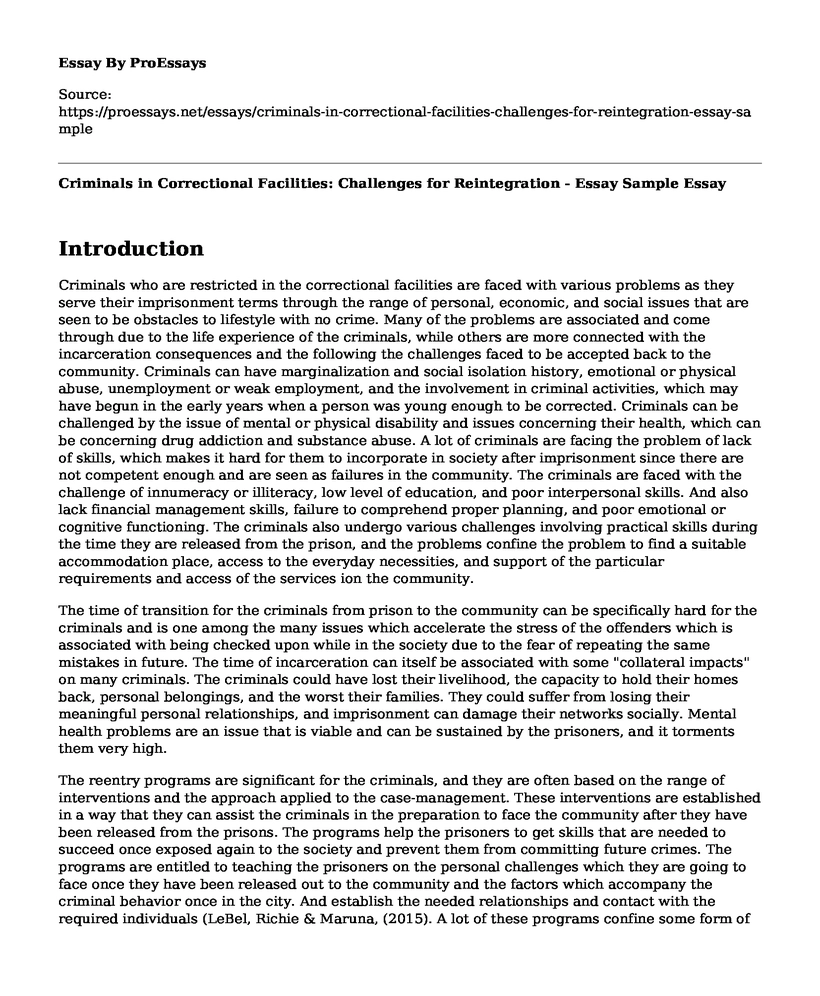Introduction
Criminals who are restricted in the correctional facilities are faced with various problems as they serve their imprisonment terms through the range of personal, economic, and social issues that are seen to be obstacles to lifestyle with no crime. Many of the problems are associated and come through due to the life experience of the criminals, while others are more connected with the incarceration consequences and the following the challenges faced to be accepted back to the community. Criminals can have marginalization and social isolation history, emotional or physical abuse, unemployment or weak employment, and the involvement in criminal activities, which may have begun in the early years when a person was young enough to be corrected. Criminals can be challenged by the issue of mental or physical disability and issues concerning their health, which can be concerning drug addiction and substance abuse. A lot of criminals are facing the problem of lack of skills, which makes it hard for them to incorporate in society after imprisonment since there are not competent enough and are seen as failures in the community. The criminals are faced with the challenge of innumeracy or illiteracy, low level of education, and poor interpersonal skills. And also lack financial management skills, failure to comprehend proper planning, and poor emotional or cognitive functioning. The criminals also undergo various challenges involving practical skills during the time they are released from the prison, and the problems confine the problem to find a suitable accommodation place, access to the everyday necessities, and support of the particular requirements and access of the services ion the community.
The time of transition for the criminals from prison to the community can be specifically hard for the criminals and is one among the many issues which accelerate the stress of the offenders which is associated with being checked upon while in the society due to the fear of repeating the same mistakes in future. The time of incarceration can itself be associated with some "collateral impacts" on many criminals. The criminals could have lost their livelihood, the capacity to hold their homes back, personal belongings, and the worst their families. They could suffer from losing their meaningful personal relationships, and imprisonment can damage their networks socially. Mental health problems are an issue that is viable and can be sustained by the prisoners, and it torments them very high.
The reentry programs are significant for the criminals, and they are often based on the range of interventions and the approach applied to the case-management. These interventions are established in a way that they can assist the criminals in the preparation to face the community after they have been released from the prisons. The programs help the prisoners to get skills that are needed to succeed once exposed again to the society and prevent them from committing future crimes. The programs are entitled to teaching the prisoners on the personal challenges which they are going to face once they have been released out to the community and the factors which accompany the criminal behavior once in the city. And establish the needed relationships and contact with the required individuals (LeBel, Richie & Maruna, (2015). A lot of these programs confine some form of supervision programs within themselves; however, not all of them have supervision.
Programs are primarily established to clear and enhance the understanding of the dynamic risk, which is concerned with the recidivism of the criminals and the problems which the criminals are faced with in the lifestyles when there are released from the prisons. The variation of programs is based on the risk of recidivism and the kind of social integration problems that they are made to counter.
References
Glass, D. (2016). The investigation into the rehabilitation and reintegration of prisoners in Victoria. ADVANCING CORRECTIONS JOURNAL: EDITION# 1-2016, 101.
LeBel, T. P., Richie, M., & Maruna, S. (2015). Helping others as a response to reconcile a criminal past: The role of the wounded healer in prisoner reentry programs. Criminal justice and behavior, 42(1), 108-120.
Leone, P., & Wruble, P. (2017). Prison Education: Maximizing the Potential for Employment and Successful Community Reintegration. The Abell Report. Volume 30, No. 6. Abell Foundation.
Cite this page
Criminals in Correctional Facilities: Challenges for Reintegration - Essay Sample. (2023, Mar 14). Retrieved from https://proessays.net/essays/criminals-in-correctional-facilities-challenges-for-reintegration-essay-sample
If you are the original author of this essay and no longer wish to have it published on the ProEssays website, please click below to request its removal:
- Research Paper on Los Angeles County's Criminal Street Gangs
- Comparison of Clinton and Obama Health Care Systems Essay
- Essay Sample on IRS Scams and Tax Fraud
- Essay on Right to Liberty & Equity: Ensuring Fair Living for All
- Literary Analysis Essay on Chained in Silence
- A Federal Court Sounds the Alarm on the Privacy Harms of Face Recognition Technology - Free Paper
- Promoting Peace and Justice: An In-Depth Interview with Jeff Stack from Fellowship of Reconciliation USA







